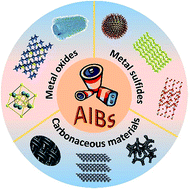Different positive electrode materials in organic and aqueous systems for aluminium ion batteries
Abstract
Recently, with large-scale energy storage equipment gradually becoming the research hotspot in the field of electrochemistry, rechargeable aluminium ion batteries (AIBs) have been described as the most promising candidate to substitute for well-developed lithium ion batteries due to their advantages of cost-effectiveness, favorable security and environmental friendliness. Nevertheless, owing to the inherent gap between theoretical experiments and commercial applications, the storage capacity, battery potential and energy density need to be improved to a large degree. In this regard, attention should be paid to two crucial factors impacting the electrochemical performance, that is the positive electrode materials and electrolytes. Therefore, this review is focused on a variety of positive electrode materials, such as transition metal oxides, metal sulfides, carbonaceous materials and other types of materials based on two main electrolyte systems, i.e., the organic system and the aqueous system. In this paper, not only is the working intercalation mechanism comprehensively concluded, but the results of relevant electrochemical experiments for AIBs are also compared and analyzed in detail. Furthermore, the challenges and prospects of improving rechargeable AIBs are also proposed.

- This article is part of the themed collection: Recent Review Articles


 Please wait while we load your content...
Please wait while we load your content...